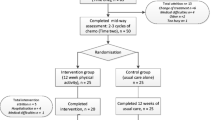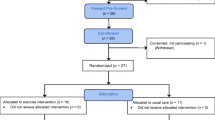Abstract
Goals of work
To evaluate a 12-week home-based walking intervention among breast cancer survivors and to quantify changes in physical activity (PA) behaviors, body weight, and body composition in response to the intervention.
Patients and methods
Breast cancer survivors that were in the posttreatment period were randomized to intervention (n=23) or wait-list usual care (n=13). PA was assessed by self-report, and in a study subsample (n=23), by an accelerometer. Intention to treat principles were employed to estimate the intervention effect on PA behaviors, body weight, and body composition. Intervention adherence was calculated as the proportion of exercise sessions completed relative to the number of exercise sessions recommended, as reported each week on walking logs.
Main results
Thirty-four of 36 women randomized (94%) completed the study. Average intervention adherence over 12 weeks was 94%. Intervention participants reported a significantly greater increase in walking for exercise [+11.9 metabolic equivalent (MET)-h/week] over time than did usual care participants (+1.7 MET-h/week, p=0.01). Objective measures of activity also indicated that intervention participants increased their activity levels over time as compared to usual care participants [i.e., counts/min/day and steps/day (p≤0.04)]. No significant changes in body weight or composition were observed.
Conclusion
We found that a 12-week home-based walking intervention was safe and effective for increasing short-term PA levels in breast cancer survivors. Future studies are needed to assess the ability of brief interventions to facilitate the maintenance of increased activity levels and to produce favorable quality of life and risk factor outcomes.


Similar content being viewed by others
References
ACSM (2004) ACSM position stand on the appropriate intervention strategies for weight loss and prevention of weight regain for adults. Med Sci Sports 33:2145–2156
American Cancer Society (2005) Cancer facts and figures—2005. American Cancer Society, Atlanta, GA
Byers T, Nestle M, McTiernan A, Doyle C, Currie-Williams A, Gansler T, Thun M (2002) American cancer society guidelines on nutrition and physical activity for cancer prevention: reducing the risk for cancer with healthy food choices and physical activity. CA Cancer J Clin 52:92–119
Cardinal BJ, Esters J, Cardinal MK (1996) Evaluation of the revised physical activity readiness questionnaire in older adults. Med Sci Sports Exerc 28:468–472
Castro CM, King AC (2002) Telephone-assisted counseling for physical activity. Exerc Sport Sci Rev 30:64–68
Chlebowski RT, Aiello E, McTiernan A (2002) Weight loss in breast cancer patient management. J Clin Oncol 20:1128–1143
Conn VS, Hafdhal A, Porock DC, McDaniel R, Nielsen PJ (2006) A meta-analysis of exercise interventions among people treated for cancer. Support Care Cancer 14:699–712
Courneya KS (2003) Exercise in cancer survivors: an overview of research. Med Sci Sports Exerc 35:1846–1852
Courneya KS, Friedenreich CM, Quinney HA, Fields AL, Jones LW, Fairey AS (2003) A randomized trial of exercise and quality of life in colorectal cancer survivors. Eur J Cancer Care 12:347–357
Courneya KS, Friedenreich CM, Sela RA, Quinney HA, Rhodes RE, Handman M (2003) The group psychotherapy and home-based physical exercise (group-hope) trial in cancer survivors: physical fitness and quality of life outcomes. Psycho-Oncology 12:357–374
Courneya KS, Mackey JR, Bell GJ, Jones LW, Field CJ, Fairey AS (2003) Randomized controlled trial of exercise training in postmenopausal breast cancer survivors: cardiopulmonary and quality of life outcomes. J Clin Oncol 21:1660–1668
Fairey AS, Courneya KS, Field CJ, Bell GJ, Jones LW, Mackey JR (2003) Effects of exercise training on fasting insulin, insulin resistance, insulin-like growth factors, and insulin-like growth factor binding proteins in postmenopausal breast cancer survivors: a randomized controlled trial. Cancer Epidemiol Biomark Prev 12:721–727
Frison L, Pocock SJ (2005) Repeated measures in clinical trials: analysis using mean summary statistics and its implications for design. Stat Med 11:1685–1704
Ganz PA, Kwan L, Stanton AL, Krupnick JL, Rowland JH, Meyerowitz BE, Bower JE, Belin TR (2004) Quality of life at the end of primary treatment of breast cancer: first results from the moving beyond cancer randomized trial. J Natl Cancer Inst 96:376–387
Holmes MD, Chen WY, Feskanich D, Kroenke CH, Colditz GA (2005) Physical activity and survival after breast cancer diagnosis. JAMA 293:2479–2486
Jones LW, Courneya KS (2002) Exercise counseling and programming preferences of cancer survivors. Cancer Pract 10:208–215
Kotler DP, Burastero S, Wang J, Pierson RN Jr (1996) Prediction of body cell mass, fat-free mass, and total body water with bioelectrical impedance analysis: effects of race, sex, and disease. Am J Clin Nutr 64:489S–497S
Kristal AR, Curry SJ, Shattuck AL, Feng Z, Li S (2000) A randomized trial of a tailored, self-help dietary intervention: the puget sound eating patterns study. Prev Med 31:380–389
Laird NM, Ware JH (1982) Random-effects models for longitudinal data. Biometrics 38:963–974
Littell R, Milliken G, Stroup W, Wolfinger R (1996) SAS system for mixed models. SAS, Cary, NC, p 633
Matthews CE, Ainsworth BE, Hanby CL, Pate RR, Addy C, Freedson PS, Jones DA, Macera CA (2005) Development and testing of a short physical activity recall questionnaire. Med Sci Sports Exerc 37:986–994
McTiernan A, Ulrich C, Kumai C, Bean D, Schwartz R, Mahloch J, Hastings R, Gralow J, Potter JD (1998) Anthropometric and hormone effects of an eight-week exercise-diet intervention in breast cancer patients: results of a pilot study. Cancer Epidemiol Biomark Prev 7:477–481
McTiernan A, Tworoger SS, Ulrich CM, Yasui Y, Irwin ML, Rajan KB, Sorensen B, Rudolph RE, Bowen D, Stanczyk FZ, Potter JD, Schwartz RS (2004) Effect of exercise on serum estrogens in postmenopausal women: a 12-month randomized clinical trial. Cancer Res 64:2923–2928
Mock V, Pickett M, Ropka ME, Muscari LE, Stewart KJ, Rhodes VA, McDaniel R, Grimm PM, Krumm S, McCorkle R (2001) Fatigue and quality of life outcomes of exercise during cancer treatment. Cancer Pract 9:119–127
Partridge AH, Burstein HJ, Winer EP (2001) Side effects of chemotherapy and combined chemohormonal therapy in women with early-stage breast cancer. J Natl Cancer Inst Monographs 30:135–142
Pinto BM, Clark MM, Maruyama NC, Feder SI (2003) Psychological and fitness changes associated with exercise participation among women with breast cancer. Psycho-Oncology 12:118–126
Pinto BM, Frierson GM, Rabin C, Trunzo JJ, Marcus BH (2005) Home-based physical activity intervention for breast cancer patients. J Clin Oncol 23:3577–3587
Schwartz AL (2004) Physical activity after a cancer diagnosis: psychosocial outcomes. Cancer Investig 22:82–92
Segal R, Evans W, Johnson D, Smith J, Colletta S, Gayton J, Woodard S, Wells G, Reid R (2001) Structured exercise improves physical functioning in women with stages I and II breast cancer: results of a randomized controlled trial. J Clin Oncol 19:657–665
Segar ML, Katch VL, Roth RS, Garcia AW, Portner TI, Glickman SG, Haslanger S, Wilkins EG (1998) The effect of aerobic exercise on self-esteem and depressive and anxiety symptoms among breast cancer survivors. Oncol Nurs Forum 25:107–113
Stewart AL, Mills KM, King AC, Haskell WL, Gillis D, Ritter PL (2001) CHAMPS physical activity questionnaire for older adults: outcomes for interventions. Med Sci Sports Exerc 33:1126–1141
Thompson FE, Subar AF, Smith AF, Midthune D, Radimer KL, Kahle LL, Kipnis V (2002) Fruit and vegetable assessment: performance of 2 new short instruments and a food frequency questionnaire. J Am Diet Assoc 102:1764–1772
Acknowledgements
We would like to thank Ms. Amy Skiba, M.S., for her dedicated efforts on behalf or the Breast Cancer Walking Study. This research was supported financially by the Vanderbilt-Ingram Cancer Center, the South Carolina Cancer Center, and the Vanderbilt General Clinical Research Center (M01 RR-00095).
Author information
Authors and Affiliations
Corresponding author
Rights and permissions
About this article
Cite this article
Matthews, C.E., Wilcox, S., Hanby, C.L. et al. Evaluation of a 12-week home-based walking intervention for breast cancer survivors. Support Care Cancer 15, 203–211 (2007). https://doi.org/10.1007/s00520-006-0122-x
Received:
Accepted:
Published:
Issue Date:
DOI: https://doi.org/10.1007/s00520-006-0122-x




